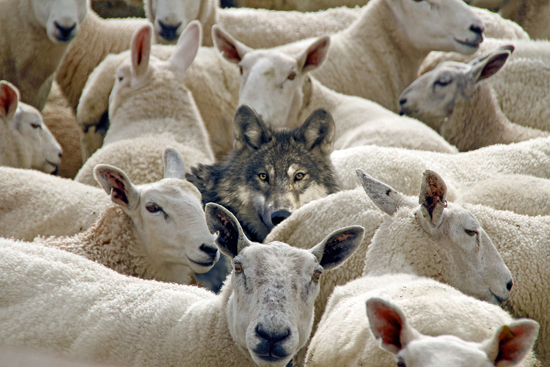There are those who believe there are two types of people, wolves and sheep. According to this view, we are divided into two camps: predators and prey.
In the animal world, this commonly is true, populations of prey vastly outnumbering predators. These large populations support progressively smaller populations of predators, who themselves in turn are vulnerable as prey to apex predators at the very top of the food chain. We humans, animals after all, have modeled society in similar terms, and never more so than now in our age of consumerism. In this context, “consumer” can be translated as “prey.”
The wolves among us are trolling for victims constantly; we call this activity “advertising.” In this way, consumers are sheep, prey for packs of predators seeking to feed on the economic lifeblood of humanity by plying irresistible lures and traps of desire. Ceaselessly stalking, dangling images and ideas about happiness and fulfillment through the acquisition of material goods and entertainment, the wolves among us mercilessly work their trade through methods ranging from shockingly crude to ultra-sophisticated.
In the world of business, refining such methods is known as “knowing your customer.” An effective predator carefully selects victims, gauging vulnerability and carefully studying habits before striking. For modern predators, such “market research” involves convening focus groups comprised of typical prey during which objections and points of escape are identified so that they may later be overcome. Once this victim research is completed, the predation phase begins.
At their worst, crazed predators so thoroughly exhaust the economic lifeblood of prey that huge numbers of new victims must constantly be cultivated and exploited. We call this type of predation “capitalism.” This fleecing of masses of people is necessary to support the small cohort at the top. That cohort includes the CEOs and top executives of multi-national corporations and the institutional shareholders who receive regular dividends and enjoy capital gains. Comprising less than 1% of the total population, such apex predators have accumulated the lion’s share of the worlds wealth.
My home is chock-filled with evidence that I’m a sheep. In fact, my home itself supports a corporate wolf feeding on my checking account every month through a mortgage. Cable TV, phone service, insurance policies, a variety of pharmaceuticals, chocolate bars, cell phones, utilities, dish soap…I’ve been sold and fed upon by wolves over and over again. Now the predators are assiduously tracking me online, watching everything I do, recording what interests me and then dangling ads and sales offers to me no matter where online I roam. There’s no hiding in the weeds or long grass, getting lost in the trees, or trying to run away; once the wolf pack picks up my scent it relentlessly pursues me.
Thus, from this perspective, the naturally primitive way of the world–life feeding on life–forms the dominant underlying structure of modern human society. As such, it’s not terribly removed from the most ancient of our animal inclinations. Despite our best efforts to cultivate a society that’s predator-free, one where principles of sharing and cooperation replace predation, global consumerism inclines and perpetuates the wolves-and-sheep dynamic.
In nature, when a population of prey becomes exhausted and collapses, so too does the population of predators collapse. In this way, apex predators become extinct. Baa, baa, baa.

I spent many years pursuing large pension and investment sales. We would develop a strategy and campaign focused on finding the decision maker. Often we started by attending or exhibiting at Conferences. The prey never knew they were being hunted. The results of a big sale were delicious! Wolf.